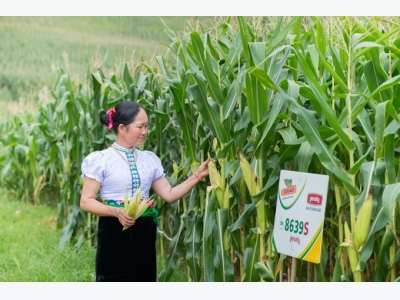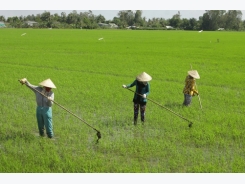Việt Nams corn imports to continue

A corn field in Mộc Châu District in Sơn La Province. — VNS Photo
HCM CITY — Việt Nam imported 3.53 million tonnes of corn in the first half of this year, up 5.6 per cent over the same period last year, according to the Crop Production Department.
Last year 8.5 million tonnes had been imported, a year-on- year increase of 9.5 per cent, with Argentina, Brazil accounting for 47.2 per cent and 41.2 per cent of the imports.
The imports this year are expected to match last year’s, the department said.
The area under corn in Việt Nam reached 1.15 million hectares last year, with output being 5.24 million tonnes, the department said.
According to the Institute of Policy and Strategy for Agriculture and Rural Development (IPSARD), about eight million tonnes, mostly from imports, are used every year to produce animal feed.
The rest is directly used for food, food processing and producing bio-energy, it said.
IPSARD has forecast that demand for corn used to produce animal feed is expected to increase to 9 million tonnes by 2020, and the country will continue to rely on imports.
With high production cost and low yields, domestic output is unable to compete with imports, it said.
Besides, taxes on corn imports are likely to decline in the future.
The country hopes to have 1.16-1.26 million hectares under corn cultivation by 2020 and 950,000-1.1 million hectares by 2025, and output of 5.4-5.8 million tonnes and 4.8-5.5 million tonnes a year, respectively.
The sector would focus on measures to cut production costs and improve competitiveness, it said.
Based on the national master zoning plan for corn production, cities and provinces need to review their corn zoning plans, and the zoning plans must connect production with purchase, processing, preservation, and consumption, it said.
Hybrid corn varieties with high productivity, quality and protein and resistance to pests, cold, drought and others need to be created to improve value addition, it said.
Localities should co-operate with businesses to produce F1 hybrid strains to meet the demand for seeds, it said.
The sector needs to complete the extensive farming technical package to apply in practice to raise productivity, cut costs and improve competitiveness, it said.
The department also encouraged businesses, especially animal feed production companies, to establish close links with corn farmers and co-operatives to buy fresh corn at main growing areas as well as invest in drying system to help farmers dry their products to improve product quality.
In Việt Nam, corn is an important food crop after rice, especially for people in mountainous areas.
Có thể bạn quan tâm
Phần mềm

Phối trộn thức ăn chăn nuôi

Pha dung dịch thủy canh

Định mức cho tôm ăn

Phối trộn phân bón NPK

Xác định tỷ lệ tôm sống

Chuyển đổi đơn vị phân bón

Xác định công suất sục khí

Chuyển đổi đơn vị tôm

Tính diện tích nhà kính

Tính thể tích ao hồ



 Mekong farmers plant high-yield Japanese rice
Mekong farmers plant high-yield Japanese rice  Lam Dong to develop 11 sustainable agricultural production…
Lam Dong to develop 11 sustainable agricultural production…